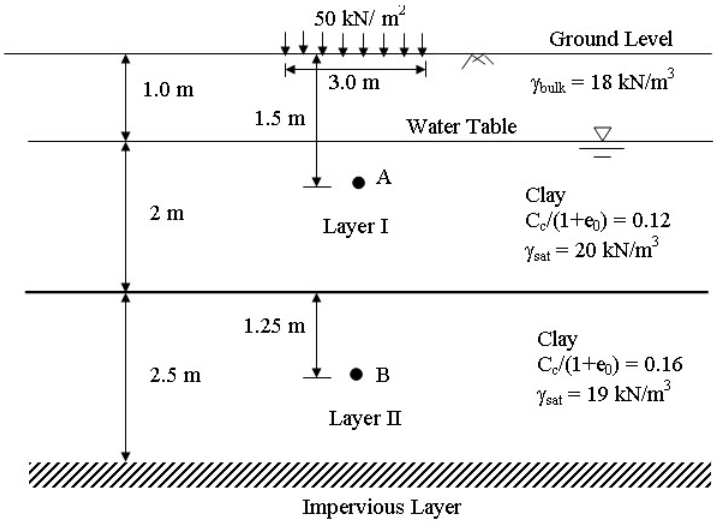Examples - Determination of Coefficient of Consolidation of Soil, Soil Mechanics | Soil Mechanics Notes- Agricultural Engineering PDF Download
Problem 1
Determine the total settlement of two layered soil system as shown in Figure 24.3. A strip loading of intensity 50 kN/m3 of width 3 m is applied at the ground surface. The water table is at a depth of 1.0 m below ground level.

Fig. 24.3. Settlement calculation of two layered soil system.
Solution:
The thickness of the Layer I and II is 3m and 2.5m, respectively. Choose one point at the middle of each normally consolidated clay layer. Here point A is chosen at a depth of 1.5 m from the ground level (if loading is applied at any depth from the ground level, then the point in the layer I will be chosen as middle of the soil layer in between the loading depth and top of the layer II. In layer II, point will be chosen at the middle of the layer II). The point B is chosen at a depth of 1.25m from the top of the layer II (or 4.25 m below the ground level).
Layer I
At point A,
σ'v0 = 18 × 1 + (1.5 – 1) × (20 – 10) = 23 kN/m2
Δσ'v = 50 × 3 /(3+1.5) = 33.33 kN/m2 (taking 1:2 distribution of loading)
H1 = 3m (if loading is applied at a depth, then H1 will be taken as total thickness of layer I minus the depth of the loading).
\[{S_1}={{{C_c}} \over {1 + {e_0}}}{H_1}{\log _{10}}\left( {{{{{\sigma '}_{v0}} + \Delta {{\sigma '}_v}} \over {{{\sigma '}_{v0}}}}} \right) = 0.12 \times 3 \times {\log _{10}}\left( {{{23 + 33.33} \over {23}}} \right)=140mm\]
Layer II
At point B,
σ'v0 = 18 × 1 + 2 × (20 – 10) + 1.25 (19-10) = 49.25 kN/m2
Δσ'v = 50 × 3 /(3+4.25) = 20.69 kN/m2 (taking 1:2 distribution of loading)
H2 = 2.5m (if loading is applied at a depth, then H2 will be taken as total thickness of layer II).
\[{S_2}={{{C_c}} \over {1 + {e_0}}}{H_2}{\log _{10}}\left( {{{{{\sigma '}_{v0}} + \Delta {{\sigma '}_v}} \over {{{\sigma '}_{v0}}}}} \right) = 0.16x2.5x{\log _{10}}\left( {{{49.25 + 20.69} \over {49.25}}} \right)=60.93mm\]
Total settlement = S1+S2= 140 +60.93 = 200.93 mm
FAQs on Examples - Determination of Coefficient of Consolidation of Soil, Soil Mechanics - Soil Mechanics Notes- Agricultural Engineering
| 1. What is the coefficient of consolidation of soil? |  |
| 2. Why is it important to determine the coefficient of consolidation of soil? |  |
| 3. How is the coefficient of consolidation of soil determined? |  |
| 4. What factors affect the coefficient of consolidation of soil? |  |
| 5. How can the coefficient of consolidation of soil be used in agricultural engineering? |  |














